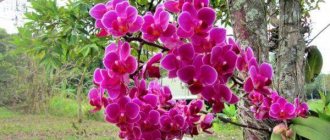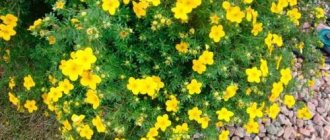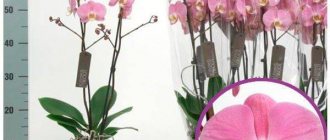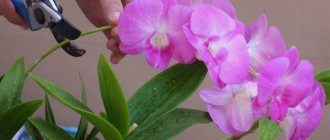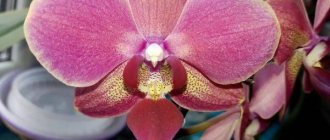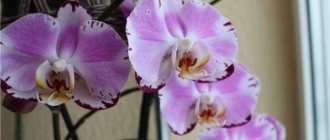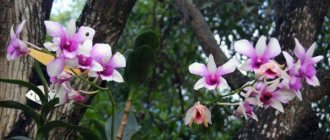It turns out that orchids of the genus Phalaenopsis differ not only in color, but also in the size of buds, leaves and peduncles, as well as the shape of flowers and the ability to produce several arrows at the same time. Based on these characteristics, about 70 species of this genus of orchids are distinguished. And there are even more varieties and hybrids!
Miniature and giant, with one or several peduncles, with regular or original bud shapes - that's all of them, phalaenopsis. And since it is so easy to get confused in them, we will allow ourselves to reflect the most accurate classification, indicating the most popular types and varieties.
Due to their popularity, some varieties and hybrids of phalaenopsis can be presented in several varieties at once.
Types and varieties
Breeders have developed many species of miniature tropical plants. New products appearing every year have different shades of inflorescences and differ in the duration of flowering. Orchid growers share photos of dwarf orchids. The most popular varieties:
| Varieties | Distinctive features |
| Pink | The name of the variety was given by the color of the flowers. This is one of the smallest orchids. The size of the leaf blades usually does not exceed 8 cm, and the length of the peduncles is 20 cm. Up to 15 small inflorescences bloom on one plant, their size is about 3 cm. |
| Mini Mark | A hybrid bred from the dwarf variety Micro Nova and phalaenopsis. Its flowers are white, with pink or yellow specks. Lip color is brownish. The leaf plates of the Mini Mark orchid are of a rich shade, up to 15 cm long. |
| Multiflora | A feature of multiflora is the appearance of a large number of medium-sized buds. Plants often branch heavily, and their flower stalks do not stop growing even during the flowering period. |
| Luddeman | The variety is named after the French breeder. Height - up to 20 cm. 6-7 buds of unusual striped color simultaneously bloom on one peduncle. Their color is deep purple, with brownish tips. |
| Philadelphia | The hybrid was obtained based on several varieties of phalaenopsis. Its leaf plates are distinguished by a silver-green, “marble” color, and the petals are purple. |
| Cattleya | This is a popular variety of mini orchids. One of the most common varieties is called “Walkera”. Its leaves are dark green, about 10 cm long. And the inflorescences are large in size, up to 8 cm. |
| Hummingbird | A distinctive feature is the shape of the flowers, similar to a star. Outwardly, it resembles a hummingbird. Peduncles are miniature, up to 12 cm in length. They produce several flowers that do not fade for up to 45 days. |
| Cymbidium | One of the most unpretentious small orchids. Its flower stalks, about 15 cm high, grow among narrow, long leaf blades. White or pink flowers bloom on them, emitting a delicate aroma. |
Varietal features
A large number of varieties of orchids classified in the genus in question are practically incapable of living in a house. But fortunately, there are many flowers adapted to such conditions. There are now about 65 of them.
This is interesting: the name “phalaenopsis”, the species of which (almost all) come from Australia, Indonesia and some regions of Southeast Asia, is translated as “night butterfly”.
In general, the plant is a relatively low herbaceous perennial with very dense leaves, collected at the base and extending directly into the roots. The latter have the ability to collect moisture and nutrients directly from the air. This, however, is not a unique property - many other genera of orchids have it.
The leaf of phalaenopsis is elongated, leathery, and quite hard. During the year, the plant produces flower stalks (sometimes their number reaches six). Depending on the variety, they produce up to 50 buds each. As a rule, the size of the latter is 45 mm, but sometimes they are much larger, less often smaller.
To learn to distinguish phalaenopsis varieties, you will need to study an entire encyclopedia. For a general understanding of the specifics of the type of information, much less is required.
So, the orchids included in it are:
- high (up to 100 cm);
- compact (no more than 30 cm).
Plants are also divided into:
- monochrome (that is, painted in one tone - yellow, white, purple, pink);
- multicolor (combining two or more shades).
Finally, among the plants there are also aromatic varieties.
In the catalogs, varietal phalaenopsis orchids are divided into groups. For home gardeners, the greatest interest is in hybrids, that is, artificially bred and most adapted species.
There are also mini flowers, characterized by their small size and amazing variety of petal shades. Taiwanese phalaenopsis amaze with their splendor - they produce large, intricately colored buds.
The Novelty category includes orchids that need rest after flowering. This group is distinguished by variegated shades, the petals are decorated with patterns and fancy spots.
If varietal phalaenopsis have a very diverse color, then, so to speak, “wild” ones are mostly white. Even striped species are not difficult to find in culture.
The most valuable ones now are:
- tiger orchids;
- black;
- raspberry;
- pearl;
- burgundy;
- blue.
Important: in stores it is not difficult to find plants with pretty blue flowers. Don’t rush to buy them - most likely, the petals are simply artificially colored, which means that after some time the pigment will fade.
What is the difference between mini and midi orchids?
The main difference is the height of the plants and the size of the blooming buds. Mini orchids rarely exceed 20 cm, their peduncles are very fragile, the flowers are no more than 4 cm. Midi grow 55 cm, their buds reach 6-7 cm in diameter.
Features of flowering
Most varieties can bloom year-round; some produce buds in winter and spring. Up to 15 flowers can appear on peduncles. Due to their fragility, it is often necessary to install supports. Some varieties of decorative orchids bloom in lush clusters and are planted in hanging pots and baskets. Blooming buds do not fade for up to 30 days. To prolong flowering, orchid growers advise placing the pot with the flowering plant in a shaded place and watering it less often.
Phalaenopsis diseases
The capricious guest of the subtropics can get sick if you care for her incorrectly.
Brown spotting. It usually affects orchid flowers - brown or pink specks appear on the petals (3). The disease does not affect other parts of the plant. Grows in damp and cool conditions.
To combat the disease, the drugs Rakurs or Topsin-M are used (4).
Bacterial brown spot. It starts as small, dirty green, watery spots on the leaves. As the disease progresses, the spots become larger and their color changes to brown. On phalaenopsis, this disease develops very quickly and soon affects the growth point (3), after which the plant may die.
If the lesions are small, the affected areas should be cut out to healthy tissue and sprinkled with coal dust. And then treat the plants with Rakurs or Topsin-M (4).
Rust. It appears on the leaves in the form of spots, which very quickly become covered with an orange coating of spores of the pathogenic fungus. This disease usually does not lead to death, but the plants are severely retarded in development and bloom poorly.
To combat this pathogen, the drugs Ikarus, Pharaoh, Falcon, and Chistotsvet are used (4).
Growing conditions
The question of how to care for a mini orchid is usually not difficult for gardeners. Plants require fertilizing during active growth at intervals of 2 weeks and replanting every 2-3 years.
Temperature
In the room where tropical flowers are kept, the temperature must be maintained from +180 to +250 C. They must be protected from drafts and sudden temperature changes, otherwise they may die. At night, the room should not cool down by more than 50 C. If in the summer the pot can be kept on the balcony or loggia, then in the winter it must be brought into a warm room.
Flower placement in the house
Exotic plants require good lighting. At the same time, they should be protected from direct sunlight to prevent burns to the leaf plates.
Air humidity
Mini orchids feel uncomfortable in conditions of high air humidity; in such conditions, their root system can rot. The best humidity level is 30% to 40%. If the air is too dry, the plants may drop their buds. You can keep containers of water nearby and practice spraying. This helps regulate humidity.
Substrate
It is recommended to grow small orchids not in a substrate containing tree bark, but in sphagnum moss. It retains moisture for a long time, so you can’t water it too often, otherwise the roots may rot.
Pot
Planting containers are usually small, about 8 cm in diameter. They can be placed inside flowerpots that match the interior. The walls of the pot should be transparent. This provides light access to the roots and allows you to monitor their condition.
Lighting
Mini orchids should receive moderate lighting. They require protection from direct rays that can cause burns. In the winter months, additional lighting does not hurt.
Watering mode
The frequency of watering depends on the substrate. It is recommended to moisturize plants by immersion in fresh, clean, settled water. Its temperature should be 50 C higher than the air in the room. If there is moss in the pot, reduce watering. Moisture must be added after the soil has dried.
Reproduction
At home, only vegetative propagation methods are suitable for propagating orchids:
- Plant a baby, which can form on a peduncle or grow from a dormant bud of the root system.
- Plant a flower that has formed a pair of stems in different pots.
- Cut, then root the top of the flower, which has several leaves. The “parent” plant will recover after some time.
The flower cannot be propagated by seeds at home. There are a number of reasons:
- The seeds have a fine texture. They are always on flowers.
- In order for seeds to germinate, a microclimate with special characteristics is needed, which is difficult to provide at home.
The main difficulty is that orchids cannot pass on all properties to their descendants. The set of genes in a grown child will be exactly the same as that of a flower, and accordingly the color and shape will be the same.
Phalaenopsis pests
Spider mite. It usually affects the leaves and buds of phalaenopsis plants (3). Hidden on the leaves on the underside. The first signs of the disease are numerous light spots on the leaves. Then webs appear on them.
To combat this pest, the drugs Kleschevit and Fitoverm are used (4).
Flat red tick. It affects many types of orchids, including phalaenopsis. Damaged leaves become gnarled, thickened, and covered with a silvery coating (3). When heavily infested, they dry out.
Thrips. Very small agile insects with narrow bodies. The leaves are affected - characteristic silvery dotted lines appear on them (3).
To combat thrips, the drug Actellik is used.
Scale insects and false scale insects. These are small insects covered with a durable shell. They settle on all common plants, but especially like to hide in the axils of leaves (3).
Pests are removed with a cotton swab soaked in alcohol. Then the plant is washed with soapy water. The remains of scale insects are destroyed with the drug Actellik.
Mealybugs. They infect leaves, and they can be recognized by waxy secretions that look like lumps of cotton wool.
Affected plants should be washed in the shower with soap. Then spray with Aktara or Actellik (3). After 2 weeks, repeat the treatment.
